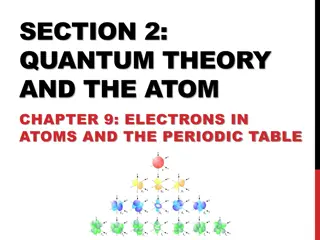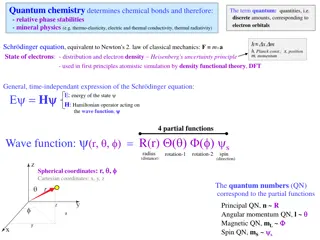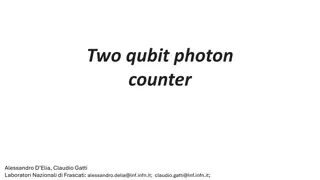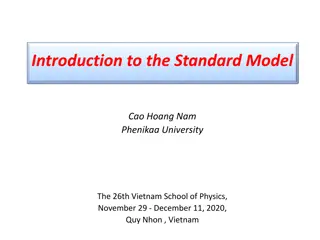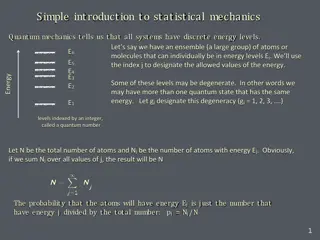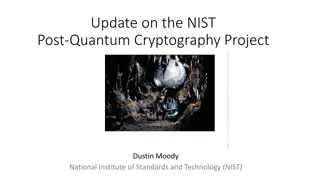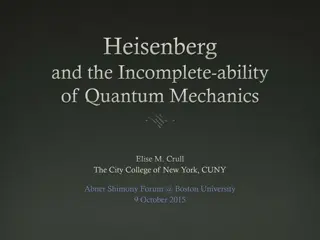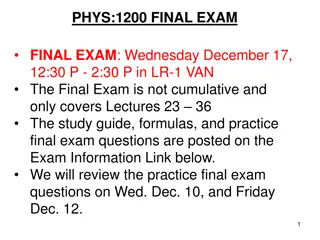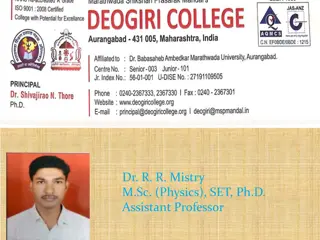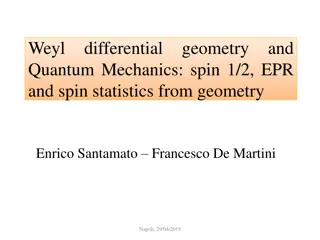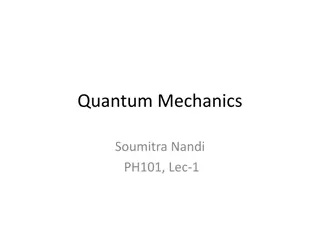Heisenberg's Uncertainty Principle in Elementary Quantum Mechanics
Heisenberg's Uncertainty Principle, proposed by German scientist Werner Heisenberg in 1927, states the impossibility of simultaneously and accurately determining the position and momentum of microscopic particles like electrons. This principle challenges classical concepts of definite position and momentum and arises from the inherent nature of particles, leading to limitations in measurement accuracy due to factors like wave-particle duality and photon interactions. The mathematical expression of this uncertainty principle defines a fundamental limit to the precision of measuring position and momentum.
- Heisenbergs Uncertainty Principle
- Quantum Mechanics
- Werner Heisenberg
- Physical Chemistry
- Electron Behavior
Download Presentation

Please find below an Image/Link to download the presentation.
The content on the website is provided AS IS for your information and personal use only. It may not be sold, licensed, or shared on other websites without obtaining consent from the author. Download presentation by click this link. If you encounter any issues during the download, it is possible that the publisher has removed the file from their server.
E N D
Presentation Transcript
JANATA SHIKSHAN SANTHAS KISAN VEER MAHAVIDYALAYA, WAI DEPARTMENT OF CHEMISTRY TOPIC- ELEMENTARY QUANTUM MECHANICS BSc III SEMESTER V PAPER XI PHYSICAL CHEMISTRY PRESENTED BY MISS. RAJESHWARI SHIVAJI KAMATE Chemical Thermodynamics
HeisenbergsUncertainty Principle - Statement - To explain the behaviour of electron ,German scientist Werner Heisenberg in 1927 have given a statement called as Heisenberg Uncertainty Principle which is stated as, Simultaneous and accurate determination of position and momentum (velocity) of a microscopic particle such as electron is impossible .
In classical terms, when we think of a particle we think it to have a definite mass and when in motion to have a definite position and momentum at a definite time. However Werner Heisenberg pointed out that it was not possible, even in principle to determine both exact position and momentum, simultaneously of a particle like electron; if position is determined accurately the velocity (or momentum) becomes uncertain and vice versa. This uncertainty is not due to any lack of precision in measurement but due to inherent nature( wave- particle duality) of the particle. Qualitatively this can be understood as follows.Suppose we want to locate the exact position of an electron.Ordinary light cannot be used for this purpose as its wavelength is many time greater than the size of the electron. Light of shorter wavelength (ex. X-rays) has to be used.The position of the electron will be revealed by the scattering of the X-ray photon.
But in this process,the electron will suffer a recoil with the photon, and due to Compton effect it will suffer a change in the momentum. Since there is no mean to determine the change in momentum,it is not possible to know the exact original momentum of the electron. Thus the accuracy of measurement of position(x) is limited by wavelength( ) of the photon used, and the minimum uncertainty( x) is equal to .The smaller the , the more accurately will be the position known,but by the equation(1), , greater will be momentum of the photon. This will result in greater recoil of the electron and greater uncertainty in the determination of momentum( p). The principle of uncertainty is expressed mathematically as, x. px h ..(2)
Equation. 2 may be derived in various way. Heisenberg derived it theoretically. Consider however an electron moving along the y axis, let it pass through a slit of width d to fall on a fluorescent screen where its position is recorded by production of a spot. Fig.1. Diffraction of electron waves
There will be points of minimum and maximum intensity due to destructive and constructive interferences. When two waves originate from two points such that their path lengths to the screen differ by /2, they will be out of the phase and the intensity of the wave will be minimum ( point P and Q on the screen), and when the path length differ by (in phase) the intensity will be maximum (point E on the screen). Let two such waves originating from the point A and D in the slit travelling along AP and DP interfere destructively to produce the intensity minimum at P. Cutting from DP a distance CP is equal to AP gives DP - AP =DC = /2.But the distances AP and DP are so large compared to the size (d) of the slit that the APC 0 or PAC = ACP 900. Then PDE = DAC 900 - ADC =
The uncertainty in the x-co-ordinate of the position of a single electron is given by equation 3 ..(3) Fig.3. x and y components of momentum
Near the slit, where the electron is moving along the y-axis,the x-component of p,i.e., px is zero .On diffraction,angular range is 2 ; but px = p sin ..(4) At the point P or Q the value of px is governed by the angle of diffraction ,hence the uncertainty px is p sin - 0 =p sin .Hence, Which is same as equation .2
One Dimensional Simple Harmonic Oscillator- A diatomic vibrating molecule can be represented by a simple model ,the so called simple harmonic oscillator.(S.H.O) According to Hooke s law, the force acting on the molecule is given by f = - kx The potential energy V(x) of this molecule is given by- .(1) Eqn.(1) is the equation of a parabola.Thus, if we plot potential energy of a particle executing simple harmonic oscillations as a function of displacement from the equilibrium position, we get a curve as shown in Fig .1
Fig.1.Potential energy diagram for a simple harmonic oscillator The vibrational frequency of the oscillator of mass m is given by (2) It is more accurate to define the vibrational frequency as- (3)
Where is the reduced mass of the diatomic molecule defined as .(3) Where m1 and m2 are the atomic masses of the two atoms. Using the potential energy given by eqn.1,for one-dimensional S.H.O.,the Schr dinger equation is represented as- (x) ..(4) Mathematically, Eq.4 may be written as (5) Defining and as = and = , (6) Eqn.5 becomes .(7)
Defining a new variable = 1/2 x, the above equation becomes (8) Eq.8 has a solution of the form (9) Using this solution, eqn.8 becomes .(10) Eq.10 is identical in form to a well known second order differential equation, called the Hermite equation, The Hermite equation has solutions which depends upon the value of n.These solution are called Hermite polynomials,Hn( ),i.e., ( ) Hn( ).
The Hermite polynomial of degree n is defined as .(12) A few Hermite polynomials are given below: H0( ) = 1 H3( ) = 8 3 -12 H1( ) = 2 H4( ) = 16 4-48 2 +12 H2( ) = 4 2 -2 The normalized wave functions of the one dimensional S.H.O.are then written as- ..(13) Where n =0,1,2,3, ..
The first three wave functions(with n=0,1,2,3.),the corresponding energy levels and the probability functions 2n for the S.H.O.,are shown in fig.2 Fig.2. The wave function, the probability functions and the energy levels of a simple harmonic oscillator.
Energyof S.H.O. - The energy of the S.H.O.is obtained by comparing eqns.10 and 11,hence we find that- / = 2n + 1 (14) Substituting for and from eqn.6,we have (2mE/ 2)(mk)1/2/ = 2n + 1 (15) Or .(16) From eqn.2,(k/m)1/2 =2 .(17) Combining eqn .16 and 17,we have
; n =0,1,2,3,4,( =h/2) .(18) The energy state with n = 0 is the vibrational ground state with energy (19) This energy is called the zero point energy of the oscillator.
The Rigid Rotor (or Rotator) - A diatomic molecule rotating about an axis perpendicular to the internuclear axis and passing through the centre of gravity of the molecule,constitutes an example of a rigid rotor,it being assumed that the internuclear distance does not change during rotation.The kinetic energy(K.E.) of the molecule is given by ..(1) Where is the angular velocity and I is the moment of inertia of the rotating molecule.The angular momentum L=I . If no force acts on the rotor,we can set the potential energy V=0.Hence, the Hamiltonian is expressed as- H = T + V =L2/2I .(2)
The expression for L2 in spherical polar coordinate(r,,) is given by- .(3) The Schr dinger equation may be written as (4) The above equation may be written as- Equation .5 contains two angular variables and .It can be solved by the methods of separation of variables,i.e,we look for a solution of form ( , ) = ( ) ( ) (6) Substituting Eq.6 into Eq.5,we obtain .(5) ..(7)
We can set both sides of eqn.7 equal to a constant ,say m2 ,thereby obtaining two differential equations each in one variable.These equation are: ..(8) (9) Where = 8 2IE/h2 Eqn.8 has the solution ( )=N exp( im ), i= -1 .(10) This wave function is acceptable provided m is an integer.This condition arises because must be single-valued.Thus, ( ) = ( +2 ) .(11) It follows,therefore,that exp(2 mi) = 1 (12) (Euler s relation) ..(13) cos 2 m + isin 2 m = 1 (14)
This can be true only if m= 0,1,2,3,.,etc. Let us now normalize the wave function ( ) to determine the normalization constant N. ..(15) Or ..(16) or N = (2 )-1/2 (17) Hence,the normalized wave functions become m( ) =(2 )-1/2 exp( im ); m=0,1,2,3, . .(18)
If = l(l+1) where l is the rotational quantum number,then this equation becomes a standard mathematical equation whose solutions are known to be associated Legendre polynomialsPl|m| (cos ) where l is either zero or a positive integer and l > |m|. The normalized solution are given by- ..(19) The energy eigenvalues of the rigid rotor are obtained as follows : =8 2IE/h2 = l(l +1) (20) Thus ..(21) In spectroscopy it is customary to use the symbol J rather than l for the rotational quantum number so that the rotational energy levels are given by the expression, ..(22)
The Schrdinger Equation for Hydrogen Atom - Hydrogen atom is the simplest of all atoms.It is a three-dimensional system and the Schr dinger equation for this system is ..(1) Where .(2) And where the Laplacian operator in Cartesian coordinates is given by (3) The potential energy of interaction between the electron and the nucleus is given by- V(r) = -Ze2/4 0r .(4)
Since this attractive potential has spherical symmetry depending only upon r,it is convenient to express the Schr dinger equation in terms of polar coordinates (r, , ),rather than Cartesian coordinates(x,y,z).The Cartesian coordinates are related to polar coordinates as follows: x = r sin cos y = r sin sin z = r cos
The Schrdinger equation for hydrogen atom in terms of polar coordinates becomes .(5) where is reduced mass, = memn/(mn+me) Assuming that V(r) is a function of r only, the above wave equation can be solved by separating the variables: (r, , ) = R(r) ( ) ( ) ..(6) Where R(r) is the radial function of r only,and ( ) and ( ) are angular functions. Substituting Eq.6 into Eq.5 we get an equation which can be separated into three equation which are : (7) ..(8)
Or ..(9) Where m and are constants. The complete solution of Eq.5 comprises the solutions of Eqns.7,8 and 9 . The energy values of hydrogen like atoms are found to be given by .(10) These energy levels are the same as those obtained from Bohr theory.The normalized solutions of radial equation.7 are found to be .(11)
Where and are the associated Legendre polynomials defined as- ..(12) Where s = 2l+1 and r = n+l and n=1,2,3,4, The number n is called the principal quantum number The probability of finding the electron between r and r+dr is given by the quantity R*(r)R(r)r2dr. Angular Wave Functions. The solution of Eq.8 gives .(13) Where are called associated Legendre polynomials defined as- .(14)
In the above equation ,the quantum number l(=0,1,2,.)is the azimuthal quantum number.It determines the shape of the atomic orbital.The solution of Eq.9 gives ..(15) Where 1/ 2 is the normalization constant and m=0, 1, 2, , l is the magnetic quantum number. To sum up ,the solution of eq.7 gives quantum numbers n and l.The solution of Eq.8 gives quantum numbers l and m, and the solution of eq.9 gives quantum number m.In other words,the quantum numbers n, l, and m follow directly from the wave mechanical treatment.
Problems- 1) Given that the work function for sodium metal is 1.82 eV,Calculate the threshold frequency 0 for sodium. Sol-We must first convert from eV to Joules =1.82 eV = (1.82 eV)(1.602 x 10-19 J.eV-1) = 2.92 x 10-19 J = h 0 0= / h = 2.92 x 10-19 J/6.626 x 10-34 J.s = 4.40 x 1014 Hz
2)When lithium is irradiated with light ,the kinetic energy of the ejected electrons is 2.935 x 10-19 J for =300.0 nm and 1.280 x 10-19 J for =400.0 nm.Calculate (a) the Planck constant, (b)the threshold frequency, and (c) the work function of lithium. Sol : (a) we know that : K.E. =h h 0 or From which we obtain , (b)Using the =300 nm data,we have =5.564 x 1014 Hz (c) =h = 3.687 x10-19 J = 2.301 eV
3) Calculate the de Broglie wavelength for a baseball(5.0 oz) travelling at 90 mph. Sol: Five ounces corresponds to,1oz = 0.0283 kg m =(5.0 oz )(0.0283kg) = 0.14 kg And 90 mph corresponds to, 1mile =1610 m The momentum of the baseball is- p = m =(0.14 kg)(40 m.s-1) =5.6 kg.m.s-1 The de-Broglie wavelength is
4) Calculate the de Broglie wavelength of an electron travelling at 1.00% of the speed of light. Sol: The mass of an electron is 9.109 x 10-31 kg.One percent of the speed of light is = (0.0100)(2.998 x108 m.s-1) = 2.998 x 106 m.s-1 The momentum of the electron is given by p = me = (9.109 x 10-31 kg)(2.998 x 106 m.s-1) =2.73 x 10-24 kg.m.s-1 The de Broglie wavelength of this electron is
5) Calculate the uncertainty in the position of a baseball thrown at 90 mph if we measure its momentum to a millionth of 1.0%. Sol 90 mph 5.6 kg.m.s-1 A millionth of 1.0% of this value is 5.6 x 10-8 kg .m.s-1 So p = 5.6 x 10-8 kg.m.s-1 The minimum uncertainty in the position of the baseball is = 1.2 x 10-26 m
6)What is the uncertainty in momentum if we wish to locate an electron within an atom, so that x is approximately 50 pm ? Sol - = 1.3 x 10-23 kg.m.s-1 Because p = m and the mass of the electron is 9.11 x 10-31 kg = 1.4 x 107 m.s-1
Transition Dipole Moment Integral- Transition probability- The transition probability is defined as the probability of particular spectroscopic transition to take place. It depends on two things- the nature of initial and final state wavefunctions. how strongly photons interact with an eigenstate. Selection rules are utilized to determine whether a transition is allowed or not. Selection rules have been divided into the electronic selection rules, vibrational selection rules, and rotational selection rules.
Transition Moment- In an atom or molecule, an electromagnetic wave can induce an oscillating electric or magnetic moment. If the frequency of the induced electric or magnetic moment is the same as the energy difference between one eigenstate 1and another eigenstate 2, the interaction between an atom or molecule and the electromagnetic field is resonant (which means these two have the same frequency). Typically, the amplitude of this (electric or magnetic) moment is called the transition moment. In quantum mechanics, the transition probability of one molecule from one eigenstate 1to another eigenstate 2is given by , and is called the transition dipole moment, or transition moment, from 1to 2.
In mathematical form it can be written as- If we have a system with n molecules and each has charge Qn, and the dipole moment operator is can be written as the is the position vector operator.
Transition Moment Integral- Based on the Born-Oppenheimer approximation, the fast electronic motion can be separated from the much slower motion of the nuclei. As a result, the total wavefunction can be separated into electronic, vibrational, and rotational parts: (r,R)= e(r,Re) v(R) r(R) The Born-Oppenheimer approximation assumes that the electronic wavefunction, e, is approximated in all electronic coordinates at the equilibrium nuclear coordinates (Re). Since mass of electrons is much smaller than nuclear mass, the rotational wavefunction, r, only depends on nuclear coordinates. The rotational wavefunction could provide important information for rotational selection rules.With the rotational part removed, the transition moment integral can be expressed as M= e(r,Re) v(R)( e+ n) e(r,Re) v(R)drdR
Both the nuclear and electronic parts contribute to the dipole moment operator. The above equation can be integrated by two parts, with nand erespectively. A product of two integral is obtained: M= e(r,Re) e e(r,Re)dr v(R) v(R)dR+ v(R) n v(R)dR e(r,Re) e(r,Re)dr Because different electronic wavefunctions must be orthogonal to each other, hence e(r,Re) e(r,Re)dr is zero, the second part of the integral should be zero. The transition moment integral can be simplified as M= e(r,Re) e e(r,Re)dr v(R) v(R)dR The above equation is of great importance because the first integral defines the electronic selection rules, while the second integral is the basis of vibrational selection rules.
Rotational Selection rules 1. Transitions with J= 1 are allowed; Photons do not have any mass, but they have angular momentum. The conservation of angular momentum is the fundamental criteria for spectroscopic transitions. As a result, the total angular momentum has to be conserved after a molecule absorbs or emits a photon. The rotational selection rule relies on the fact that photon has one unit of quantized angular momentum. During the photon emission and absorption process, the angular moment J cannot change by more than one unit. Let's consider a single photon transition process for a diatomic molecule. The rotational selection rule requires that transitions with J= 1 are allowed. Transitions with J=1 are defined as R branch transitions, while those with J=-1 are defined as P branch transitions.
2. J=0 transitions are allowed when two different electronic or vibrational states are involved: (X'', J''= m) (X', J'= m). The Q branch transitions will only take place when there is a net orbital angular momentum in one of the electronic states. Therefore, Q branch does not exist for1 transitions because electronic state does not possess any net orbital angular momentum. On the other hand, the Q branch will exist if one of the electronic states has angular momentum. In this situation, the angular momentum of the photon will cancel out with the angular momentum of the electronic state, so the transition will take place without any change in the rotational state. 1 electronic
The schematic of P, Q, and R branch transitions are shown below:
With regard to closed-shell non-linear polyatomic molecules, the selection rules are more complicated than diatomic case. The rotational quantum number J remains a good quantum number as the total angular momentum if we don't consider the nuclear spin. Under the effect of single photon transition, the change of J is still limited to a maximum of 1 based on the conservation of angular momentum. However, the possibility of Q branch is greatly enhanced irrelevant to the symmetry of the lower and upper electronic states. The rotational quantum number K is introduced along the inertial axis. For polyatomic molecules with symmetric top geometry, the transition moment is polarized along inertial axis. The selection rule becomes K=0.
Electronic Selection Rules In atoms Atoms are described by the primary quantum number n, angular momentum quantum number L, spin quantum number S, and total angular momentum quantum number J. Based on Russell-Saunders approximation of electron coupling, the atomic term symbol can be represented as2S+1LJ. 1.The total spin cannot change, S = 0; 2.The change in total orbital angular momentum can be L= 0, 1, but L= 0 transition is not allowed; 3.The change in the total angular momentum can be J = 0, 1, but J=0 transition is not allowed; 4.The initial and final wavefunctions must change in parity. Parity is related to the orbital angular momentum summation over all elections li, which can be even or odd; only even odd transitions are allowed. L= 0 J=0
. In molecules The electronic-state configurations for molecules can be described by the primary quantum number n, the angular momentum quantum number , the spin quantum number S, which remains a good quantum number, the quantum number (S, S-1, ..., -S), and the projection of the total angular momentum quantum number onto the molecular symmetry axis , which can be derived as = + . The term symbol for the electronic states can be represented as 2S+1 (+/ ) ,(g/u) Group theory makes great contributions to the prediction of the electronic selection rules for many molecules.
1. The total spin cannot change, S=0; the rule =0 holds for multiplets; If the spin-orbit coupling is not large, the electronic spin wavefunction can be separated from the electronic wavefunctions. Since the electron spin is a magnetic effect, electronic dipole transitions will not alter the electron spin. As a result, the spin multiplicity should not change during the electronic dipole transition. 2. The total orbital angular momentum change should be =0, 1; For heteronuclear diatomic molecules with C vsymmetry, a + according to selection rule. 3. Parity conditions are related to the symmetry of the molecular wavefunction reflecting against its symmetry axis. For homonuclear molecules, the g For heteronuclear molecules, + + and - Similarly, for a molecule with an inversion center, a subscript g or u is used to reveal the molecular symmetry with respect to the inversion operation, i. The x, y, and z components of the transition dipole moment operator have u inversion symmetry in molecule with inversion center.Therefore, only g transition is allowed u transition is allowed. - transitions apply; u transition is allowed.
Vibrational Selection rules 1.Transitions with v = 1, 2, ... are all allowed for anharmonic potential, but the intensity of the peaks become weaker as v increases. 2. v = 0 to v = 1 transition is normally called the fundamental vibration, while those with larger v are called overtones. 3. v = 0 transition is allowed between the lower and upper electronic states with energy E1and E2are involved, i.e. (E1, v' = n) (E2, v = n), where the double prime and prime indicate the lower and upper quantum state. The geometry of vibrational wavefunctions plays an important role in vibrational selection rules. For diatomic molecules, the vibrational wavefunction is symmetric with respect to all the electronic states. Therefore, the Franck-Condon integral is always totally symmetric for diatomic molecules. The vibrational selection rule does not exist for diatomic molecules
For polyatomic molecules, the nonlinear molecules possess 3N-6 normal vibrational modes, while linear molecules possess 3N-5 vibrational modes. Based on the harmonic oscillator model, the product of 3N-6 normal mode wavefunctions contribute to the total vibrational wavefunction, i.e. vib= 3N 6 1 2 3... 3N 6 We will use CO2as an example to specify the vibrational selection rule. CO2has four vibrational modes as a linear molecule. The vibrational normal modes are illustrated in the figure below:
Vibronic Coupling Why can some electronic-forbidden transitions be observed as weak bands in spectrum? It can be explained by the interaction between the electronic and vibrational transitions. The word "vibronic" is the combination of the words "vibrational" and "electronic. Because the energy required for one electronic state to another electronic state (electronic transition, usually in the UV-Vis region) is larger than one vibrational state to another vibrational state (vibrational transition, usually in the IR region), sometimes energy (a photon) can excite a molecule to an excited electronic and vibrational state. The bottom figure shows the pure electronic transition (no vibronic coupling) and the electronic transition couples with the vibrational transition (vibronic coupling).



